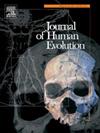中国中更新世晚期花龙洞遗址的古人类牙齿
IF 3.1
1区 地球科学
Q1 ANTHROPOLOGY
引用次数: 0
摘要
2014年至2015年间,在中国南方安徽省华隆洞遗址发现了大量距今约300年前的人类化石。HLD人类样本包括一个几乎完整的颅骨,有14颗原位牙齿,一个局部上颌,一个原位前磨牙,6个分离的牙齿,3个股骨干切片和一些颅骨碎片。以前的研究发现,HLD人族表现出一种关于人属枝的原始和衍生特征的马赛克。虽然头盖骨、四肢和下颌骨主要显示出与早期人属标本共有的原始特征,但面部骨骼显示出与现代人更接近的特征。为了评估HLD分类群与其他亚洲古人类记录以及非洲和欧洲更新世标本的系统发育亲缘性,我们对21颗HLD牙齿进行了比较形态计量学分析。我们的牙齿研究揭示了人类进化支系HLD人族的原始和衍生牙齿特征的马赛克。结果表明,除了前磨牙和磨牙的粗大根接近中更新世形态外,大部分HLD牙齿特征与晚更新世古人类相似。一些特征,如减少的M3,将HLD 6下颌骨与东亚更新世古人类和近代现代人类联系起来。HLD也缺乏典型的尼安德特人特征。该种群具有东亚大多数中更新世古人类化石组合中不存在的大量衍生牙齿特征,也许除了盘县大洞和金牛山。HLD牙齿的发现为中更新世晚期人类进化的多样性提供了进一步的支持。有几种情况可以潜在地解释这种可变性,需要进一步探索。华龙洞特有的形态可能是遗传漂变的结果,或者是更古老的形式(如直立人)的基因流动的结果。另外,HLD样本可能属于与智人分支密切相关的人类种群,与直立人、尼安德特人和丹尼索瓦人不同。本文章由计算机程序翻译,如有差异,请以英文原文为准。
The hominin teeth from the late Middle Pleistocene Hualongdong site, China
Between 2014 and 2015, abundant human fossils dated to about 300 ka were found in the Hualongdong (HLD) site, Anhui province, South China. The HLD human sample consists of a nearly complete skull with 14 teeth in situ, one partial maxilla with one premolar in situ, six isolated teeth, three femoral diaphyseal sections, and a few cranial pieces. Former studies found that the HLD hominins show a mosaic of primitive and derived characteristics with regard to the Homo clade. While the cranium, limbs, and mandible display predominantly primitive features shared with early Homo specimens, the facial bones display closer affinities to modern humans. To assess the phylogenetic affinities of the HLD taxa and other Asian hominin record as well as African and European Pleistocene specimens, we present a comparative morphometric analysis of the 21 HLD teeth. Our dental study reveals a mosaic of primitive and derived dental features for the HLD hominins regarding the Homo clade. The results show that most of the HLD dental features resemble those of Late Pleistocene hominins expect for the robust roots of premolars and molars that approach Middle Pleistocene morphologies. A few features like the reduced M3 link the HLD 6 mandible with East Asian Pleistocene hominins and recent modern humans. The HLD also lacks typical Neanderthal traits. This population presents a remarkable number of derived dental features not present in most Middle Pleistocene hominin fossil assemblages in East Asia with perhaps the exception of Panxian Dadong or Jinniushan. The findings from HLD teeth provide further support to the diversity in late Middle Pleistocene hominin evolution. Several scenarios can potentially explain this variability and would need further exploration. Hualongdong-particular morphology could be the result of genetic drift or gene flow with a more archaic form, such as Homo erectus. Alternatively, the HLD sample could belong to a hominin population closely related to the Homo sapiens clade and be distinct from H. erectus, Neanderthals, and Denisovans.
求助全文
通过发布文献求助,成功后即可免费获取论文全文。
去求助
来源期刊

Journal of Human Evolution
生物-进化生物学
CiteScore
6.30
自引率
15.60%
发文量
104
审稿时长
3 months
期刊介绍:
The Journal of Human Evolution concentrates on publishing the highest quality papers covering all aspects of human evolution. The central focus is aimed jointly at paleoanthropological work, covering human and primate fossils, and at comparative studies of living species, including both morphological and molecular evidence. These include descriptions of new discoveries, interpretative analyses of new and previously described material, and assessments of the phylogeny and paleobiology of primate species. Submissions should address issues and questions of broad interest in paleoanthropology.
 求助内容:
求助内容: 应助结果提醒方式:
应助结果提醒方式:


